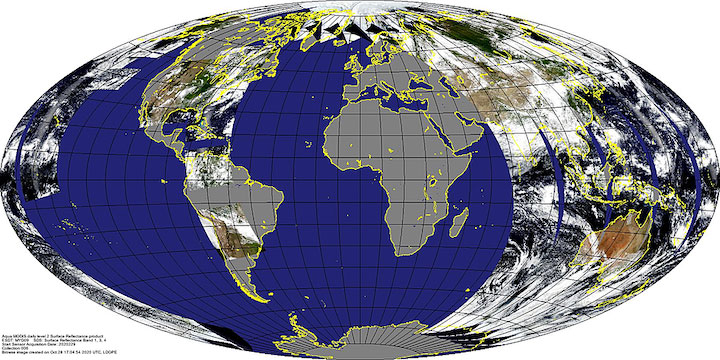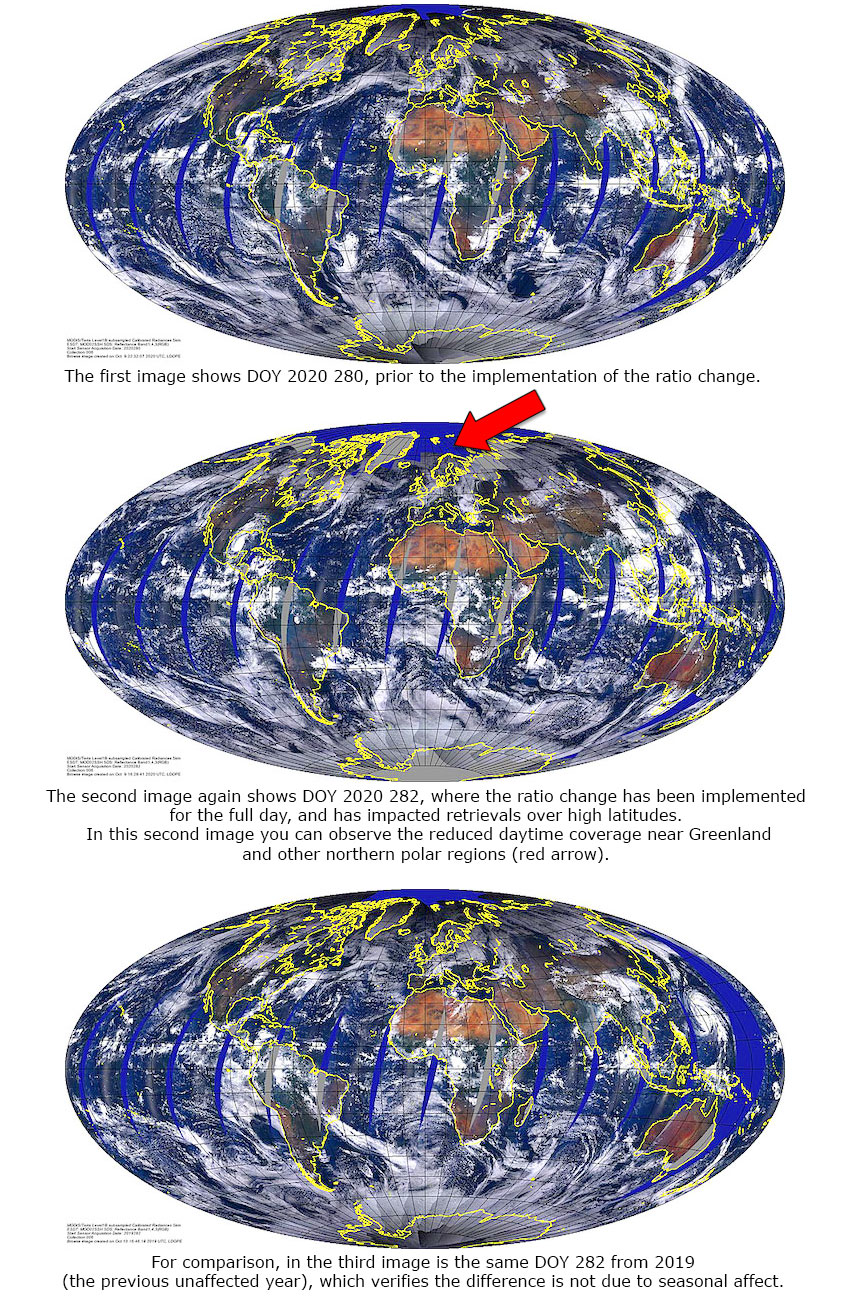Tracking of known problems and subsequent fixes is an important issue for MODIS data users. This page will act as a repository of all known MODIS Atmosphere Data Product problems, as well as how to determine the problematic version (and the fixed version) of the HDF data -- therefore data users should check this page for updates regularly. Data Users unfamiliar with how to properly track problems and fixes by determining the version of their downloaded HDF files should refer to the documentation in the Introduction sublink (the top link along the LHS of this page).
Note that a checkmark (✔) in the tables below means Data Issue or Quality Statement applies. A blank means it's been fixed or does not apply.
L1B Data Issues: Table of Contents & Anchor Links
(Note: Anchor Links point to a specific place within this page.)
| Collection/Platform where Quality Statements Apply |
|---|
| Issue | Impact |
C6.1/Terra |
C6.1/Aqua |
C6.0/Terra |
C6.0/Aqua |
| #1. Aqua FMU/SSR Anomaly |
L |
|
✔ |
|
|
| #2. Terra PWA Failure |
L |
✔ |
|
|
|
 Issue #1: Aqua FMU/SSR Anomaly
Issue #1: Aqua FMU/SSR Anomaly
Description: Aqua MODIS suffered a science data outage, starting August 16th, 2020 (2020.229) at 09:26:40, because of a FMU (Formatter-Multiplexer Unit) and SSR error. Aqua received a yellow CDH alarm that was associated with a data value mismatch error and caused by data of incorrect length. MOT was unable to recover any data from the partitions 6,16, and 9 on the SSR. Partition 6 contains housekeeping and GBAD ephemeris and attitude data. The Aqua Flight Operations Team (FOT) worked closely with the different Instrument Operations Teams (IOTs) to resolve this and was able to recover the FMU/SSR, through a soft-reset on September 2, 21:00. During the entire data outage duration MODIS on-board Aqua was in good health acquiring science quality data as verified by the direct broadcast stations and during the reset process, MODIS was held in standby mode.
Following the reset on September 2 at 21:00, MODIS resumed nominal science data collection at 20:12 UTC. MODIS standard processing stream at MODAPS and the NRT processing streams successfully processed Aqua MODIS data. MODIS Calibration Support Team verified the RSB and TEB gain trending to be free of any impact from FMU anomaly, and the NASA MODIS geolocation team verified the geolocation accuracy to be nominal. All Aqua MODIS land and atmosphere products have been found to be satisfactory.
MODAPS has reprocessed this Aqua FMU outage period (8/16 - 9/2), based on limited L0 coverage received from the various Direct Broadcast (DB) stations, via EDOS. The data from the DB stations are expected to cover between 25-30% of the globe each day. All Aqua specific L2 and L3 dailies, for this outage period have now been re-processed in C6 forward production and the data should be available from the different DAACs.
The image below from 2020-08-16 shows the extent of global coverage that is to be expected from these L0 data that have been received from the Direct Broadcast stations. In general, N. America, Europe and the Indian sub-continent shows the most consistent coverage from day to day, with limited coverage over parts of S. America. The coverage over all other areas is pretty erratic or non-existent, during this period.
It should be noted that there are plans to remove the L3 monthly Aqua data for Aug 2020 due to so many missing days in the latter half of the month.

Data Dates Affected: 16 Aug 2020 to 2 Sep 2020
Affected Platform: Aqua
Collections Affected: Collection 6.1
 Issue #2: Terra PWA Failure
Issue #2: Terra PWA Failure
Description: On DOY 2020.279 (10.05.20) MODIS Terra experienced a Printed Wire Assembly (PWA) failure that affected the PWA-41 (supersets 80 and 81), bringing down the total number of MODIS PWA to 14 with only 28 supersets. Given this, there is an increased chance of buffers being filled and data overwritten, resulting in unscheduled and unrecoverable data loss. So, Field Operations Team (FOT) and MODIS Instrument Operations Team (MODIOT) have decided to change the day/night coverage ratio from current 50/50 to 44.2/55.8 to minimize the overflow of onboard buffers. This ratio change occurred on October 7th (2020.281) at 20:00z. Due to this change there is an observed reduction in the overall Terra daytime coverage, specifically at the end of orbits in the northern latitudes. Shown directly below is a global browse image of DOY 2020.280, prior to the implementation of the ratio change. The second image shows DOY 2020.282, where the ratio change has been implemented for the full day, and has impacted retrievals over high latitudes. In this second image you can observe the reduced daytime coverage over Greenland and portions of Northern Russia as well as North America and Alaska. For comparison, in the third image is the same DOY 282 from 2019 (the previous unaffected year), which verifies the difference is not due to seasonal affect.

Data Dates Affected: ≥ 5 Oct 2020
Affected Platform: Terra
Collections Affected: Collection 6.1, L1B and downstream L2 IR Parameters

